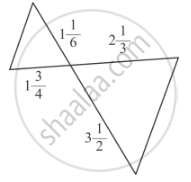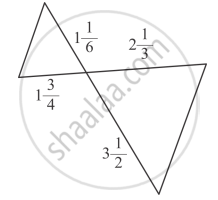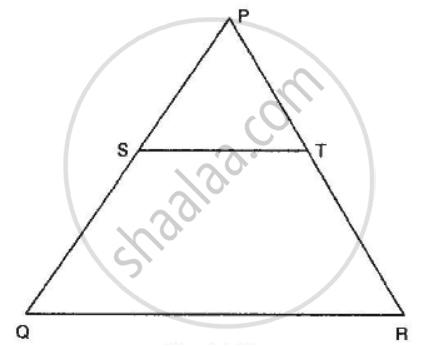Advertisements
Advertisements
Question
In each of the following figures, you find who triangles. Indicate whether the triangles are similar. Give reasons in support of your answer.

Solution
In two triangle, we observe that

`(3(1)/2)/(1(1)/6)=(2(1)/3)/(1(3)/4)`
`(7/2)/(7/6)=(7/3)/(7/4)`
`7/2xx6/7=7/3xx4/7`
`cancel7/2xx6/cancel7=cancel7/3xx4/cancel7`
`cancel(6)^3/cancel2=4/3`
`3=4/3`
In two triangles corresponding sides are not proportional to each other.
NO two triangles are not similar.
APPEARS IN
RELATED QUESTIONS
A 13m long ladder reaches a window of a building 12m above the ground. Determine the distance of the foot of the ladder from the building.
In each of the following figures, you find who triangles. Indicate whether the triangles are similar. Give reasons in support of your answer.

ABCD is a rectangle. Points M and N are on BD such that AM ⊥ BD and CN ⊥ BD. Prove that BM2 + BN2 = DM2 + DN2.
State basic proportionality theorem and its converse.
State Pythagoras theorem and its converse.
In the given figure, S and T are points on the sides PQ and PR respectively of ∆PQR such that PT = 2 cm, TR = 4 cm and ST is parallel to QR. Find the ratio of the areas of ∆PST and ∆PQR.

In a ∆ABC, ∠A = 90°, AB = 5 cm and AC = 12 cm. If AD ⊥ BC, then AD =
Two isosceles triangles have equal angles and their areas are in the ratio 16 : 25. The ratio of their corresponding heights is
In a ∆ABC, point D is on side AB and point E is on side AC, such that BCED is a trapezium. If DE : BC = 3 : 5, then Area (∆ ADE) : Area (◻BCED) =
If ABC is an isosceles triangle and D is a point of BC such that AD ⊥ BC, then
